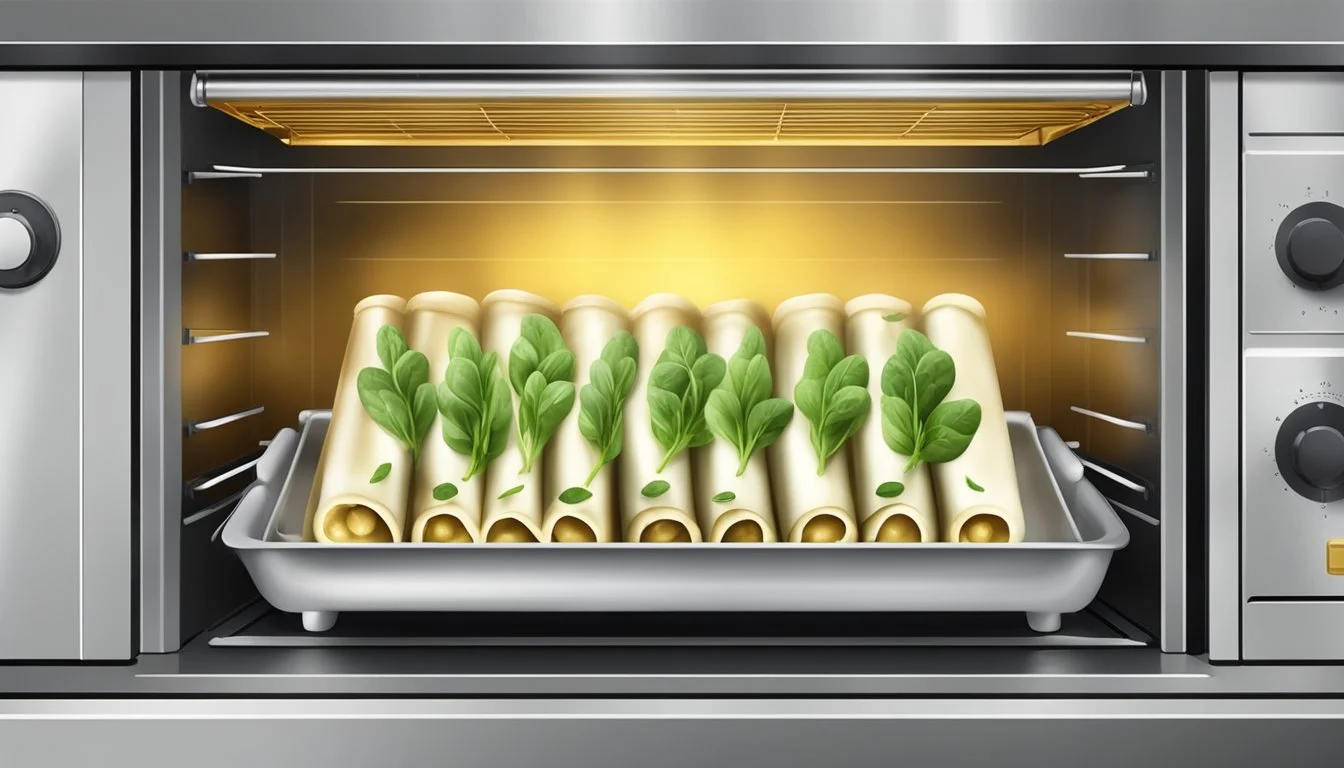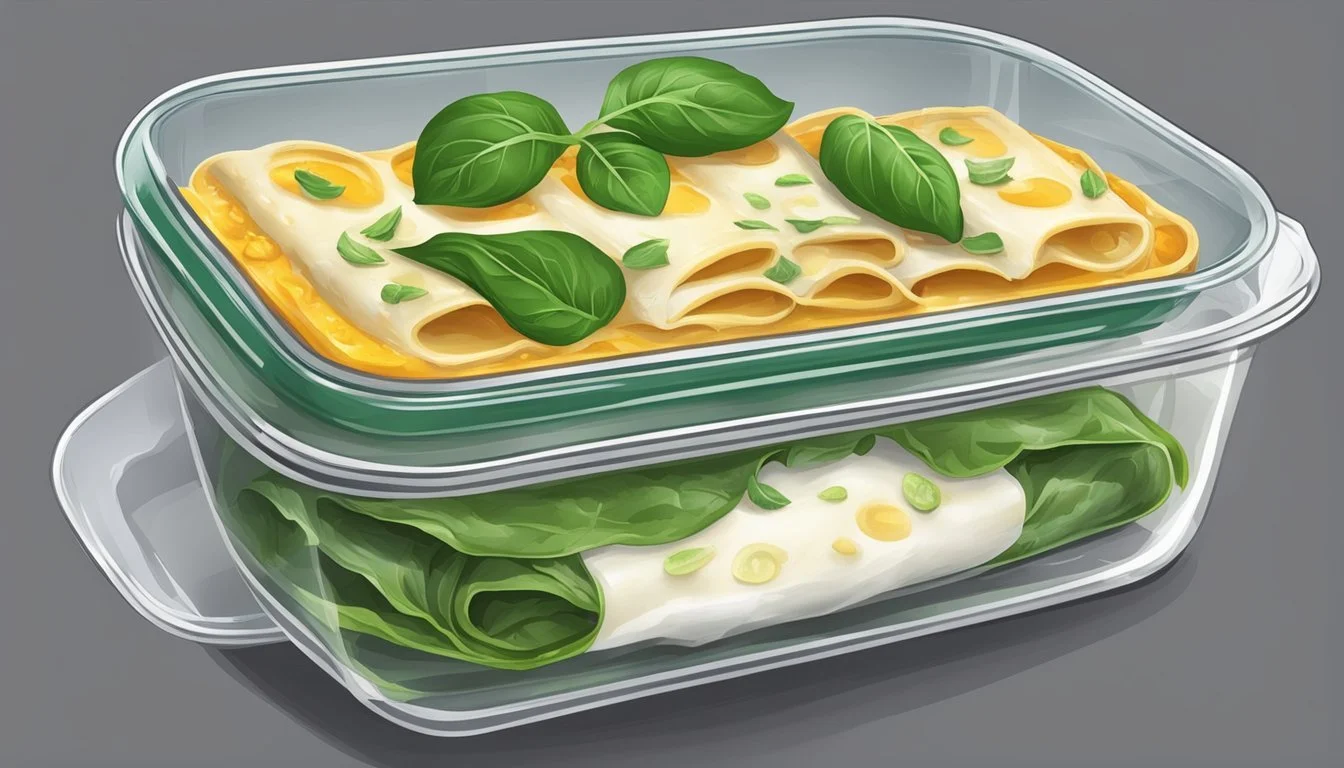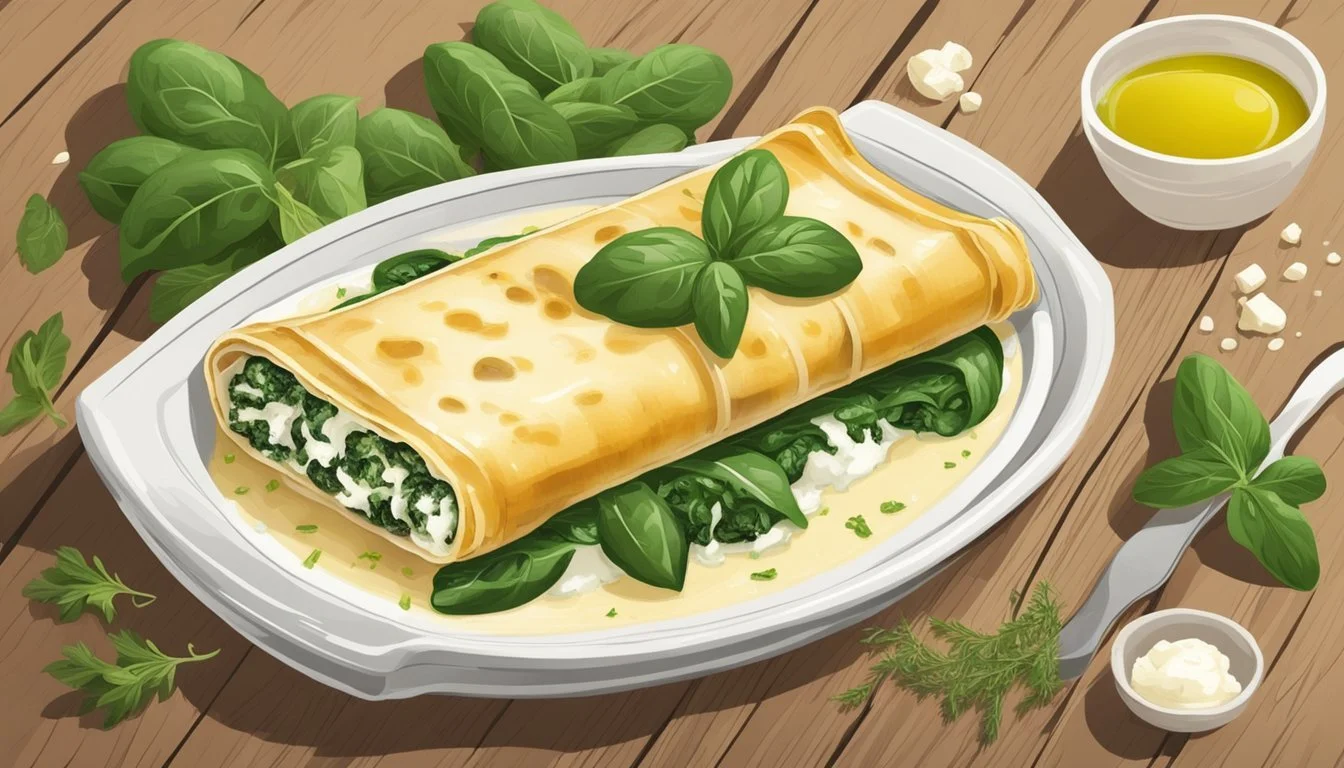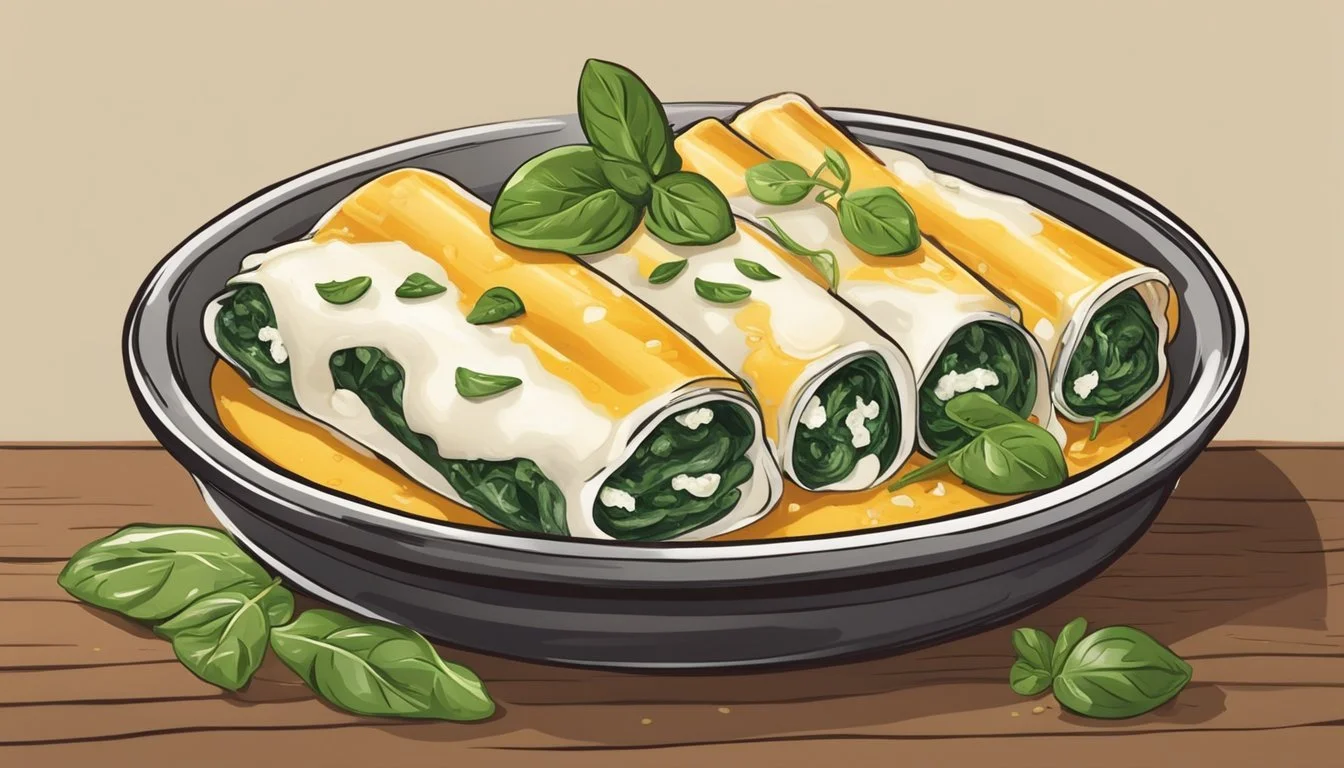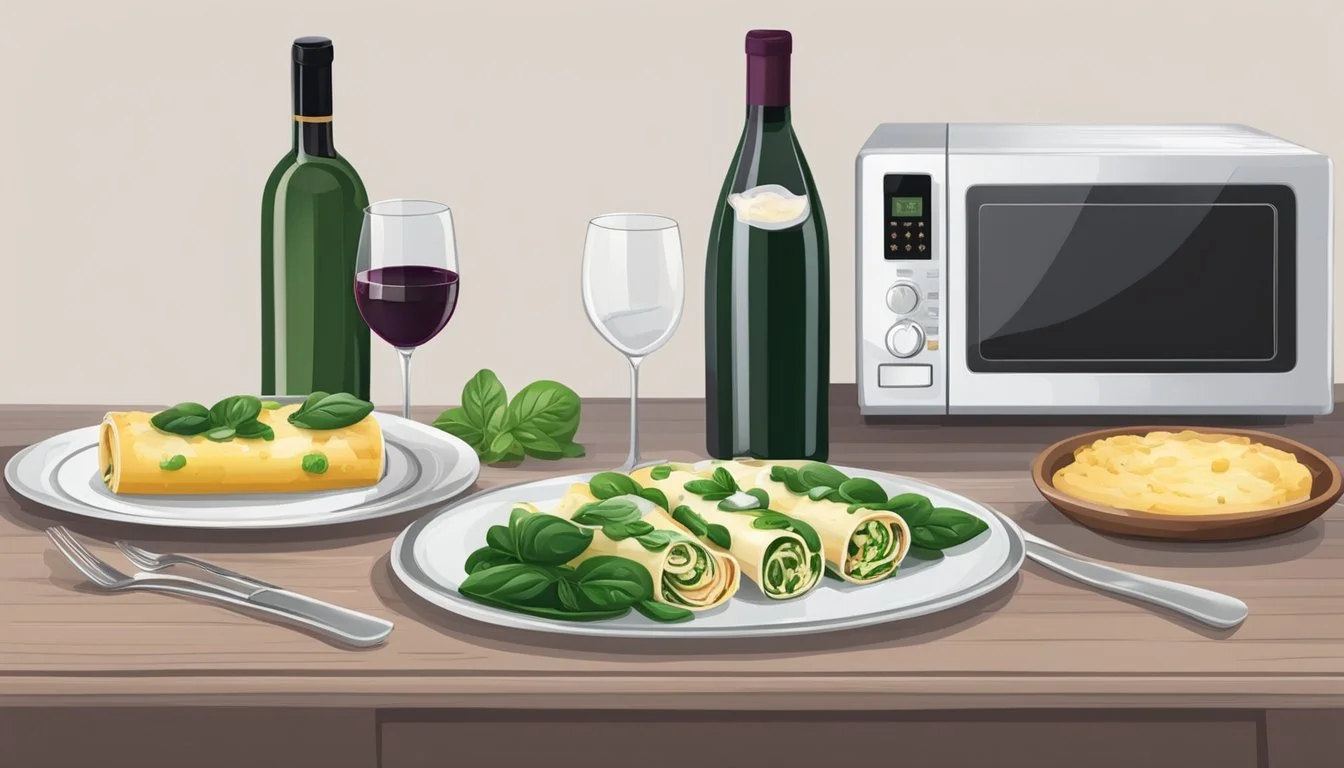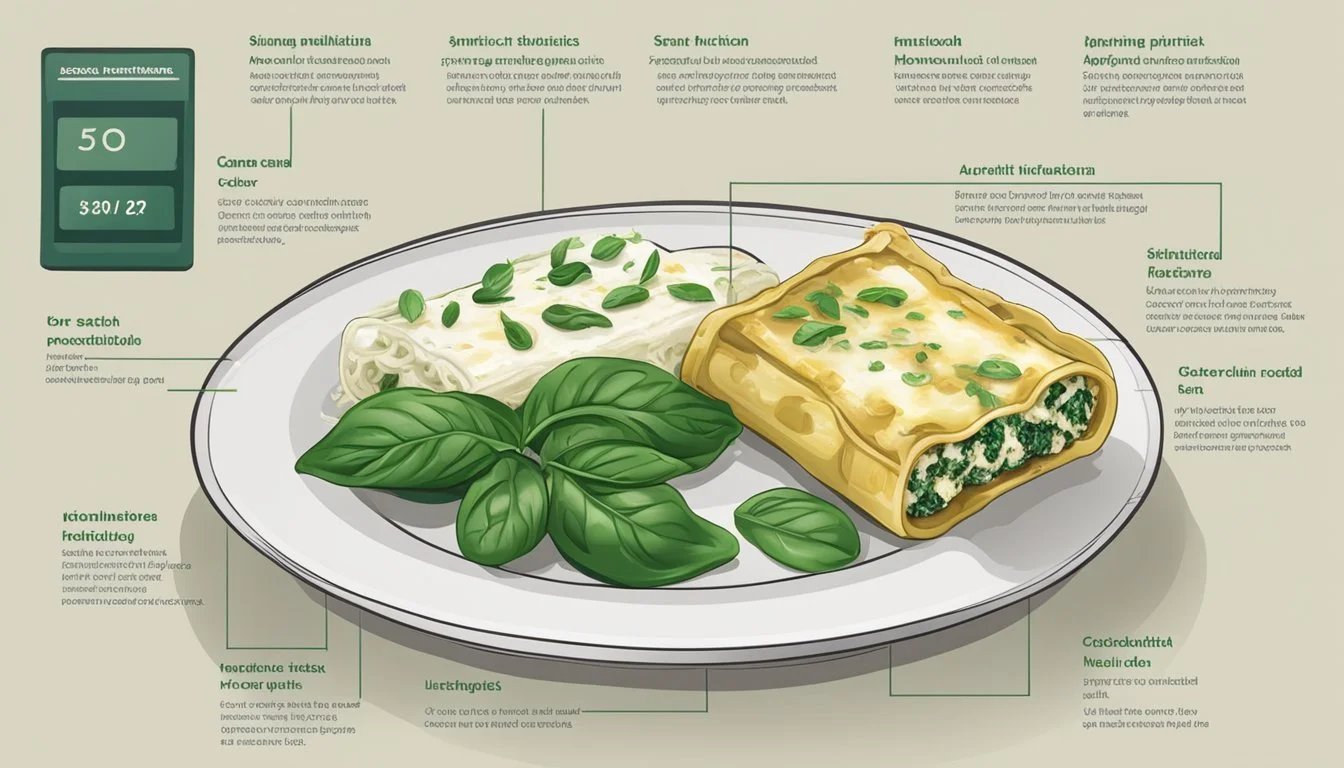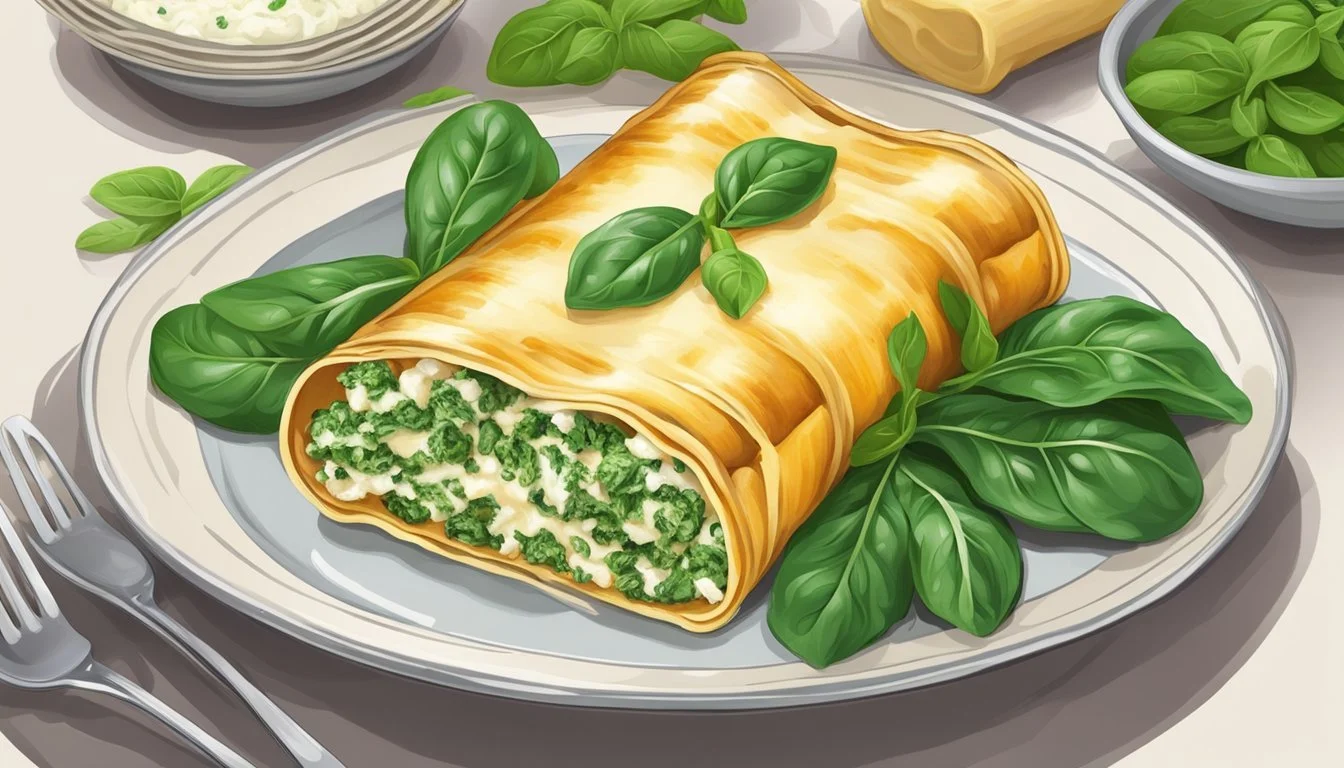Best Way to Reheat Cannelloni with Spinach and Ricotta
Ensuring Tender Pasta and Creamy Filling
Reheating spinach and ricotta cannelloni can be a delicate process, as retaining the tenderness of the pasta (What wine goes well with pasta?) and the creaminess of the filling is paramount to enjoying this delectable Italian dish a second time around. When dealing with leftover cannelloni, the objective is to warm through the center without causing the edges to dry out or the cheese to separate and become oily. The technique chosen for reheating plays a crucial role in the outcome of the dish's texture and flavor.
For oven reheating, it is recommended to preheat the oven to 350°F (175°C) and place the cannelloni in a single layer in an oven-safe dish. This ensures even heating. Covering the cannelloni with aluminum foil is crucial as it traps moisture and prevents the pasta from drying out, allowing for a gentle reheating process. In the oven, the cannelloni typically requires 20-25 minutes to reach the desired temperature throughout, ensuring that the pasta remains tender and the ricotta and spinach (What wine goes well with spinach?) filling stays creamy.
An alternative method involves using the stovetop or microwave when an oven is not available. For the stovetop, a skillet or pot provides a quicker way to reheat the pasta, with frequent stirring to distribute heat evenly. The microwave is the fastest method, requiring a microwave-safe bowl, a few tablespoons of water to maintain moisture, and appropriate covering to create steam. Both methods call for careful attention to avoid overheating and ensure the cannelloni is warmed just to the point of serving, preserving its original taste and consistency.
Preparation Before Reheating
Reheating cannelloni filled with spinach and ricotta requires careful preparation to maintain the pasta's tenderness and the filling's creaminess. Initially, one should gently remove the cannelloni from the fridge to bring it to room temperature; this will allow for more even reheating. It is recommended to let the dish sit outside for about 15-20 minutes.
One should preheat the oven to 350°F (175°C) if utilizing an oven reheating method. They must select an oven-safe baking dish that can accommodate the cannelloni in a single layer, which will ensure that heat is distributed evenly.
Microwave reheating is more expedite, yet it should be done with care to avoid rubbery pasta. For the oven method, it's crucial to cover the baking dish. This can be done with aluminum foil or an oven-safe lid. Covering the dish helps to retain moisture and heat inside, preventing the cannelloni from drying out.
Reheating Method Preparation Step Oven Let cannelloni sit until room temperature, preheat oven, place in an oven-safe baking dish, cover the dish. Microwave Let cannelloni sit until room temperature, transfer to a microwave-safe dish, lightly cover.
To sum up, one should remove cannelloni from the fridge, let it come to room temperature, prepare a baking dish for oven reheating, or a microwave-safe dish for microwave reheating. Lastly, they should ensure the dish containing the cannelloni is covered to preserve moisture and warmth.
Reheating Cannelloni in the Oven
Reheating cannelloni in the oven is ideal to maintain the pasta's tenderness and keep the spinach and ricotta filling creamy. This method ensures that the Italian cuisine's rich flavors are highlighted without compromising the dish’s texture.
Preheating the Oven
The first step is to preheat the oven to 350°F (175°C). A steady oven temperature is crucial to heat the cannelloni evenly and prevent it from drying out or getting too crispy.
Arranging the Cannelloni
Place the pasta leftovers in a single layer in an oven-safe dish. Whether using a baking dish or a baking pan, ensure space between servings for consistent reheating.
Adding Moisture
Drizzle a little extra virgin olive oil or add a few tablespoons of water to the dish to add moisture. This helps in keeping the pasta tender and the cheese—like Parmigiano Reggiano—melty. Cover the dish with aluminum foil to seal in the heat and moisture.
Oven Time and Temperature
Set the oven temperature to the preheated 350°F (175°C). The cannelloni should bake in the center of the oven for about 20-25 minutes. This duration allows the cheese to reach its optimum creaminess without losing essential calories and flavors.
Final Touches
After the suggested time, remove the foil and bake for an additional 2-3 minutes, until the cheese on top is sufficiently golden brown. Let the dish stand for a couple of minutes before serving to allow the spinach and ricotta filling to set slightly.
Microwave Reheating Method
Reheating cannelloni in a microwave is a quick solution that can preserve the tenderness of the pasta and creaminess of a spinach and ricotta filling. For nutrition retention and texture maintenance, it is essential to use low heat and short intervals.
Setting Up the Microwave
Before starting the reheating process, one must adjust the microwave's power setting to ensure gentle warming.
Power Setting: Set the microwave to 50% power for low heat application, as high temperatures can cause uneven reheating and can toughen the pasta.
Microwave Reheating Steps
Follow these steps to reheat cannelloni while maintaining a juicy filling and al dente pasta:
Preparation: Place the cannelloni in a microwave-safe dish. If the dish isn’t airtight, add a splash of water to avoid dryness.
Covering: Shield the dish with a microwave-safe lid or a layer of cling film; poke a few holes to allow steam to escape.
Heating: Microwave the dish on the half power setting for two minutes.
Stirring: If possible, gently turn the cannelloni or stir the surrounding sauce to encourage even heat distribution.
Continued Heating: Resume heating in 30-second bursts, checking temperature and texture between each.
Checking Doneness
To determine if the cannelloni is thoroughly reheated:
Touch Test: Carefully touch the pasta with a fork to check for consistent warmth.
Visual Cues: Look for steam and the cheese, such as mozzarella, becoming gooey.
Taste Test: Taste a small bit to make sure it's heated through and the flavors, especially the delicate taste of ricotta, are intact.
If the cannelloni requires further reheating, return it to the microwave and repeat the 30-second bursts until satisfactory.
Optimal Storage to Maintain Quality
Proper storage of spinach and ricotta cannelloni is crucial to maintain its tenderness and creaminess upon reheating. Careful attention to temperature and container selection can extend the shelf life and quality of this pasta dish.
Cooling Down Before Storage
Before storing leftovers, it is important to allow the cannelloni to cool down to prevent condensation inside the container that could make the pasta soggy. Cannelloni should be spread out on a dish and cooled uncovered for no more than two hours to avoid bacterial growth.
Proper Storage Containers
The chosen containers for storing cannelloni should be airtight to prevent the absorption of other flavors from the refrigerator and to keep the pasta moist. For best results, leftovers should be lightly coated with olive oil to prevent sticking. Containers should be shallow to ensure even cooling and reheating.
Ideal Containers:
Airtight plastic containers
Shallow glass dishes with lids
Heavy-duty aluminum foil for wrapping
Fridge vs. Freezer Storage
Refrigerator Storage: Freshly cooked cannelloni can be stored in the refrigerator for up to two days. The pasta and cheese preserve better at steady fridge temperatures, typically around 35-38°F (1.7-3.3°C).
Freezer Storage: Cannelloni may be frozen for later consumption. To freeze, one might first wrap servings individually in plastic wrap, then place them in a heavy-duty freezer bag or airtight container. When stored at 0°F (-18°C) or below, frozen cannelloni will maintain quality for one to two months. Reheating directly from the frozen state might require additional time.
Note on Sauce: If the cannelloni is coated in a garlic-infused pasta sauce, it should be thoroughly cooled before freezing, as sauces can separate when frozen and reheated.
Additional Tips for Best Results
When reheating cannelloni with spinach and ricotta filling, one aims to maintain the tenderness of the pasta and the creaminess of the filling. Here are some additional tips to ensure best results:
Reheating Method: The oven is preferred for its even heat distribution. Preheat it to 350°F and heat the covered cannelloni for about 20-25 minutes.
Moisture is Key: To keep the pasta from drying, add a tablespoon of water to the dish before covering it with foil.
Seasoning: Sprinkle a pinch of salt and pepper over the cannelloni before reheating to enhance flavor.
Olive Oil: A light drizzle of olive oil can prevent the pasta from sticking and add a subtle richness to the dish.
Ingredient Purpose Note Parmigiano Reggiano Adds a nutty, savory layer of flavor Grate fresh for best results Nutmeg Complements the spinach and ricotta filling Use sparingly for a hint of warmth
Substitutes: If Parmigiano Reggiano or nutmeg are not available, suitable substitutes like grated Pecorino or a dash of ground clove can be used.
Pasta Preparation: Avoid overcooking the cannelloni during initial preparation. Al dente pasta reheats better, retaining its structure and mouthfeel.
Filling: Ensure that the ricotta and spinach mixture maintains its moisture content; too much water can cause sogginess, while too dry a mixture can become grainy when reheated.
Careful attention to these aspects helps in successfully reheating cannelloni, maintaining the delicate balance between the tender pasta and the creamy filling.
Serving Suggestions After Reheating
After reheating cannelloni with spinach and ricotta, one should consider accompanying this Italian dish with sides that complement its flavors. A serving of garlic bread is a classic choice, as it not only complements the dish but also helps in savoring every bit of the creamy tomato sauce.
Garlic bread: Toasted until golden and rubbed with a garlic clove, it imparts a savory crunch that pairs well with the tender pasta.
Parmesan: A generous sprinkle of Parmesan cheese before serving adds a sharp, cheesy flavor that enhances the creaminess of the ricotta filling.
Tomato sauce: If the cannelloni appears to be less saucy after reheating, one can serve it with a side of warm tomato sauce to ensure it maintains the dish’s moisture and tangy flavor.
Basil: Fresh basil leaves can be torn and sprinkled over the reheated cannelloni to add a refreshing herbaceous note and bright color contrast.
In terms of nutrition, these serving suggestions balance the meal by adding an element of carbohydrates, fats, and vitamins:
Garlic bread: Provides carbohydrates for energy.
Parmesan: Adds calcium and protein.
Basil: Supplies vitamins A and K.
Here is a simple table to summarize the serving suggestions:
Accompaniment Flavor Profile Nutritional Contribution Garlic Bread Savory & Crunchy Carbohydrates, Energy Parmesan Sharp & Cheesy Calcium, Protein Extra Tomato Sauce Tangy & Moist Lycopene, Vitamins A & C Fresh Basil Leaves Herbaceous & Fresh Vitamins A & K
Each suggestion is designed to complement the richness of the spinach and ricotta cannelloni, creating a well-rounded and nutritious meal that is not only satisfying but also keeps the integrity of traditional Italian cuisine.
Understanding Cannelloni and Its Variants
Cannelloni, a beloved baked pasta dish, incorporates a variety of fillings, typically encased in cylindrical pasta and baked to perfection. Here is a look at its origins, classic interpretations, and the array of fillings and wraps that define its variants.
Origins and Classic Versions
Cannelloni originated in Italy, where it has been embraced as a staple of traditional Italian cuisine. The classic version of this dish involves large pasta tubes that are filled with a mixture of ingredients—most commonly, a blend of ricotta cheese, spinach, and an egg to bind the filling. Once stuffed, the cannelloni tubes are laid in a baking dish, covered with pasta sauce, often bechamel or marinara, topped with cheese, and baked until golden and bubbly.
Different Fillings and Wraps
While the classic cannelloni are usually stuffed with a vegetarian filling, there is an abundance of variations that may include:
Meat Fillings: Ranging from ground beef to pork or a combination, meat adds a rich flavor and hearty texture to the dish.
Cheese Varieties: Beyond ricotta, combinations of cheeses such as mozzarella, Parmigiano Reggiano, and pecorino enhance the creamy texture and taste.
Different Wraps: Manicotti shells are often used as an alternative to cannelloni tubes. Furthermore, some innovative recipes might even use thinly sliced vegetables, such as zucchini, as a wrap for those seeking a lower-carb option.
Cannelloni and its variants share commonalities with other baked pasta dishes like lasagne, with the key distinction being the unique tubular pasta used for cannelloni, which serves as a vessel for its sumptuous fillings.
Complementary Pairings and Wine Selection
When savoring homemade spinach and ricotta cannelloni, selecting a wine that accentuates its creamy texture and rich flavors is key. White wines are typically the go-to choice for this dish.
Chardonnay is a versatile choice that complements the creaminess of the ricotta with its full body and often buttery notes. Its balance of acidity can cut through the richness while harmonizing with the subtle flavors of spinach.
For a typical Italian experience, one might lean towards a crisp Trebbiano or Soave. These wines offer a refreshing counterpoint to the savory cannelloni, with a lighter body that won't overpower the dish.
Wine Selection Description Chardonnay Full-bodied with potential buttery notes, pairs well with the creamy texture of ricotta cheese. Italian White Varietals Acidity to cut through richness, enhancing the delicate flavors of spinach.
It is advisable to avoid wines that are too oaky or have high tannins, which could conflict with the soft textures of cannelloni.
To complement the meal with herbs, a garnish of fresh basil leaves can add a fragrant, aromatic touch. Basil offers a zesty, peppery element that contrasts nicely with the mild flavors in the filling.
A simple sauté of additional spinach on the side can make the meal even more tasty and ensure that the spinach in the dish is the star. By choosing the right wine and accompaniments, diners can elevate their enjoyment of spinach and ricotta cannelloni to new heights.
Nutritional Information Breakdown
When reheating cannelloni with spinach and ricotta, it is crucial to consider the nutritional content of this dish. The ingredients play a vital role in the overall healthfulness and calorie content.
Spinach is rich in vitamins A, C, K, iron, and folic acid, adding not only a burst of color but also nutritional value to the cannelloni. Ricotta cheese, a key component, contributes to the creamy texture, and offers a good source of protein and calcium. It is, however, also a contributor to the total fat and calorie count.
The typical ingredients of cannelloni, such as pasta, cheese, and egg, make this dish energy-dense. Below is a rough breakdown of the nutrients provided in a single serving of spinach and ricotta cannelloni:
Nutrient Approximate Value Calories 350-500 kcal Protein 15-20g Carbohydrates 35-50g Fat 10-25g Sugars 3-7g
Olive oil, often used in small amounts, contributes to the monounsaturated fat content, a believed healthier fat option. An egg is sometimes included in the cannelloni filling or in the pasta dough, adding high-quality protein and various micronutrients.
Nutritional information can certainly vary between recipes, particularly around ingredients like cheese and olive oil, which can be adjusted for lower-calorie options. Consumers concerned with calorie intake or those requiring a more precise nutrition breakdown should consult a recipe's specific nutritional content or use a food tracking application.
Exploring Leftover Cannelloni Recipes
Incorporating leftover cannelloni into new and exciting dishes can offer a fresh and delicious take on Italian cuisine. This section presents a variety of ways to reimagine leftovers in a way that maintains their original texture and flavor.
Creative Recipe Ideas
Cannelloni Frittata: Transform your leftover cannelloni by slicing them into bite-sized pieces and incorporating them into a frittata. Mix the pasta with beaten eggs, diced onions, and minced garlic, then cook in a skillet until firm. This melds the creamy filling of the cannelloni with the fluffy texture of the eggs.
Cannelloni Lasagna: Layer chopped-up cannelloni tubes, marinara sauce, and additional cheese in a baking dish to create a Lasagna-like bake. The results are a rich, cohesive dish that utilizes the existing cannelloni flavors in a new format.
Transforming Leftovers
Cheesy Cannelloni Bites: Cut leftover cannelloni into sections and dredge in breadcrumbs. Bake until crispy for a snack that highlights the tender pasta and creamy cheese filling. These bites can be paired with a garlic-infused tomato dipping sauce that complements the Italian flavors.
Stuffed Bell Peppers (What wine goes well with stuffed bell peppers?): For a hearty meal, stuff bell peppers with a mixture of leftover cannelloni filling and rice. Top with cheese and breadcrumbs, then bake until the peppers are tender. A recipe video could showcase this process in detail, providing a visual guide alongside reheating tips to ensure the filling remains creamy and the peppers cook evenly.
In each transformed dish, it's essential to reheat the cannelloni gently to preserve the pasta's tenderness and the ricotta's creaminess. Whether turning leftovers into a breakfast frittata or a savory stuffed pepper, these recipes offer tasty and inventive ways to enjoy leftover pasta.
Safety Considerations During Reheating
Reheating cannelloni filled with spinach and ricotta requires careful attention to safety to ensure the pasta remains tender and the filling creamy. Below are key safety steps to follow:
Temperature Check: When reheating cannelloni, it's crucial to reach an internal temperature of 165°F (74°C), as recommended for safe consumption by food safety guidelines.
Even Heating: Overheating can cause the delicate spinach and ricotta filling to become grainy or separate. Therefore, one should reheat cannelloni slowly and evenly in the oven or microwave.
Oven Reheating
Preheat: The oven should be set to a moderate temperature, such as 350°F (175°C), before placing the cannelloni inside.
Cover: Cover the baking dish with aluminum foil to avoid drying out the pasta and to ensure heat is distributed evenly throughout the dish.
Microwave Reheating
Add Moisture: Add a small amount of water before covering the dish. This creates steam and prevents the cannelloni from drying out.
Power Settings: Use a lower power setting or reheat in short bursts, stirring in between if possible, to avoid uneven heating and overcooking.
Safety Concerns:
Containers: Ensure all containers used are oven-safe or microwave-safe, as improper containers can release chemicals at high temperatures or cause injuries.
Handling: Use oven mitts or appropriate hand protection when removing hot dishes to prevent burns.
Final Check: After reheating, inspect the cannelloni to make sure they are heated throughout and that the temperature is consistent. This will not only guarantee safety but also protect the integrity of the meal's texture and flavors.
FAQs – Answering Common Questions
Can cannelloni be reheated in the microwave? Yes, cannelloni can be reheated in the microwave. It's advised to do it in short bursts of 1 to 1 ½ minutes, checking frequently and stirring if possible to ensure even heating.
What's the best way to reheat frozen cannelloni? The oven is ideal for reheating frozen cannelloni. Preheat it to 350°F (175°C) and bake the covered dish for about 25 minutes or until the cannelloni is heated through.
How do I keep the cannelloni crispy when reheating? For a crispy finish, remove the cover for the last few minutes of oven reheating. This will allow the edges to crisp up while ensuring the filling remains creamy.
Prep time: Generally, there's no prep time for reheating, but if frozen, thaw in the refrigerator before reheating.
Cook time: In the oven, approximately 20-25 minutes.
Total time: Depends on method; the oven will take around 25 minutes, microwave will be quicker.
Can I use a stove to reheat cannelloni without drying it out? Reheating on a stove can be challenging for cannelloni. To prevent drying, a gentle heating in a covered skillet with a bit of stock can help maintain moisture.
Essential tips for reheating:
For frozen spinach and ricotta cannelloni, thaw first for more uniform heating.
When using an oven, cover with foil to retain moisture.
Incorporate a sprinkle of water or stock when using a microwave to keep the filling from drying out.


